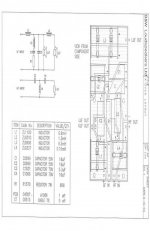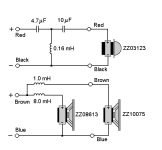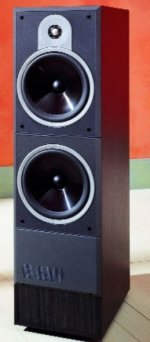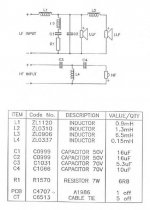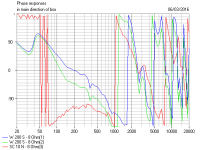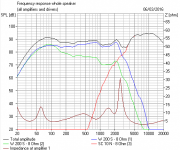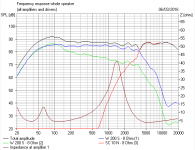Hello everybody,
There is a B&W DM-630 speaker at my friend and has to be replaced some parts. I can see that has strange 2.5-way crossover design.
I know that the 2pcs 8ohm bass are parallel with each other and can sound differently?
I also found another 2.5-way crossover design but look little different.
Can somebody explain me how they works and what is the different between them?
Appreciate,
Carlos
There is a B&W DM-630 speaker at my friend and has to be replaced some parts. I can see that has strange 2.5-way crossover design.
I know that the 2pcs 8ohm bass are parallel with each other and can sound differently?
I also found another 2.5-way crossover design but look little different.
Can somebody explain me how they works and what is the different between them?
Appreciate,
Carlos
Attachments
Hi Carlos,
There are two differences. One is electrical. For an introduction to crossovers please see my blog post here.
To learn about this design, you should try to simulate it using XSim, here.
The difference happens because of the difference in the value of the coils that go to each woofer. Plug them into XSim (select the coil, then Tune, then increase the impedance value). Use the Frequency Response Graph, and select both of the woofers.
The other difference is the difference in the two woofers. The woofer with the 8uH is probably lower Q and lower resonant frequency than the other. We'd need at least the Thiele/Small parameters (T/S) to better understand the woofers. Also, it's possible if the woofers are different that only one is ported, and the other is in a sealed cabinet.
If you still have questions, please ask then! 🙂
Best,
Erik
There are two differences. One is electrical. For an introduction to crossovers please see my blog post here.
To learn about this design, you should try to simulate it using XSim, here.
The difference happens because of the difference in the value of the coils that go to each woofer. Plug them into XSim (select the coil, then Tune, then increase the impedance value). Use the Frequency Response Graph, and select both of the woofers.
The other difference is the difference in the two woofers. The woofer with the 8uH is probably lower Q and lower resonant frequency than the other. We'd need at least the Thiele/Small parameters (T/S) to better understand the woofers. Also, it's possible if the woofers are different that only one is ported, and the other is in a sealed cabinet.
If you still have questions, please ask then! 🙂
Best,
Erik
Last edited:
Hi,
There are two types of parallel 2.5 way. One has only an inductor in series with the
lower driver. The other has the midrange low pass network in series with both drivers
and then the lower pass inductor in series with the lower driver.
The latter is generally better but at the cost of double the current in the mid crossover.
rgds, sreten.
Not common is the series 2.5 way, but FWIW it is another type.
There are two types of parallel 2.5 way. One has only an inductor in series with the
lower driver. The other has the midrange low pass network in series with both drivers
and then the lower pass inductor in series with the lower driver.
The latter is generally better but at the cost of double the current in the mid crossover.
rgds, sreten.
Not common is the series 2.5 way, but FWIW it is another type.
Hi,
Thank you for the help.
For me the second design where the 1mH and 8mH coil is in series with the woofers is simple, I understand, its a 1st order network. Here means all the 2 woofers give the same bass frequency and where the 1mH coil is give some midrange too until the tweeter. This is clear.
But how goes at the first one? There is a 2nd order crossover that rolls-off both woofers and give midrange for both at the same time. After the L3 coil series with the right woofer rolls-off again to get only deep frequencies for the right side woofer? If I understand it in a simple way...🙂 It means the right woofer get rolls-off twice? Funny...
Thank you.
Carlos
Thank you for the help.
For me the second design where the 1mH and 8mH coil is in series with the woofers is simple, I understand, its a 1st order network. Here means all the 2 woofers give the same bass frequency and where the 1mH coil is give some midrange too until the tweeter. This is clear.
But how goes at the first one? There is a 2nd order crossover that rolls-off both woofers and give midrange for both at the same time. After the L3 coil series with the right woofer rolls-off again to get only deep frequencies for the right side woofer? If I understand it in a simple way...🙂 It means the right woofer get rolls-off twice? Funny...
Thank you.
Carlos
A series half-way does not give the ~6dB increase in LF of a parallel one, just doubles the cone area.
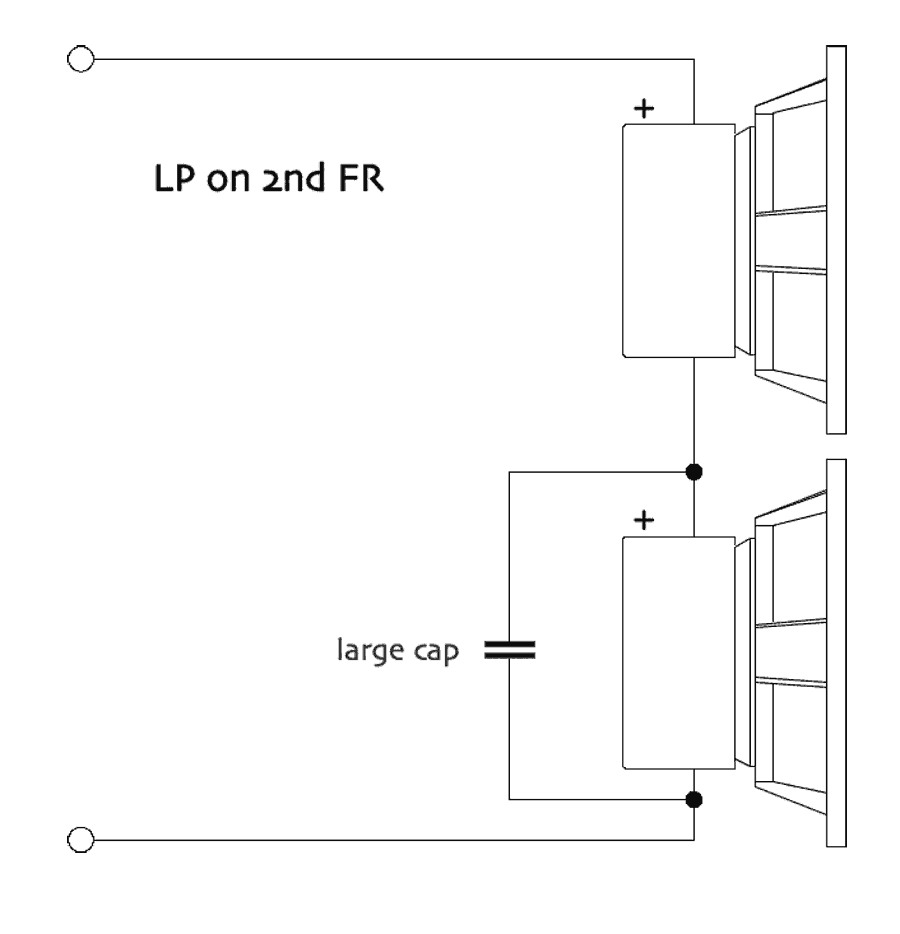
dave

dave
A series half-way does not give the ~6dB increase
in LF of a parallel one, just doubles the cone area.
dave
Hi,
Well there you are wrong, if it is done right,
but your technical point is still true and valid.
A series 2.5 way needs a series BSC inductor just
like a normal 2 way speaker to give the required
baffle step, which does not have to be the full
6dB, but the nearer to 6dB you get the more
the nominal impedance of double each drivers
impedance is maintained in the midrange.
Kef made an 8 ohm series 2.5 way with two
4 ohm bass drivers using the above approach.
rgds, sreten.
Well there you are wrong, if it is done right,
I'd love to know how.
Double the drivers, gain 3 dB,
Double the impedance, deliver ½ the power, lose 3dB.
Net gain, 0 dB.
dave
I'd love to know how.
Double the drivers, gain 3 dB,
Double the impedance, deliver ½ the power, lose 3dB.
Net gain, 0 dB.
dave
Hi,
Your saying a series 2.5 way can't work. I've said how it can.
I never said a series 2.5 way is the same as as parallel 2.5 way.
I've said they exist and how they can be implemented effectively.
Stop being so tedious and understand a useful use of 2 4ohm drivers.
rgds, sreten.
I accepted the technical point, but 2.5 way does not just mean
parallel and 6dB BSC, the series case is valid, and different.
Last edited:
I never said the series x.5 won't work, just that the common reason for doing an x.5 way is to counter bafflestep is not why you'd do a series version.
dave
dave
I never said the series x.5 won't work, just that the common reason for doing
an x.5 way is to counter bafflestep is not why you'd do a series version.
dave
Hi,
A point you totally neglected to mention, and quite true.
I only mentioned 2.5 series as an aside, and the only
reason you might be interested in 2.5 way series is
if you have 2 4 ohm bass/mid drivers and want to
use them together for 8 ohm rather than 2 ohm.
The approach exists in commercial loudspeakers.
I never said or implied 2.5 way series does BSC.
rgds, sreten.
Last edited:
You mentioned it, i posted a schema that shows how you do it and that it does not achieve the same thing as parallel x.5 way, then you said i was wrong? Is that not how it went?
We have extended the concept to 4 drivers… not sure what you'd call it. 0.75-way? (details specific to the box designed)
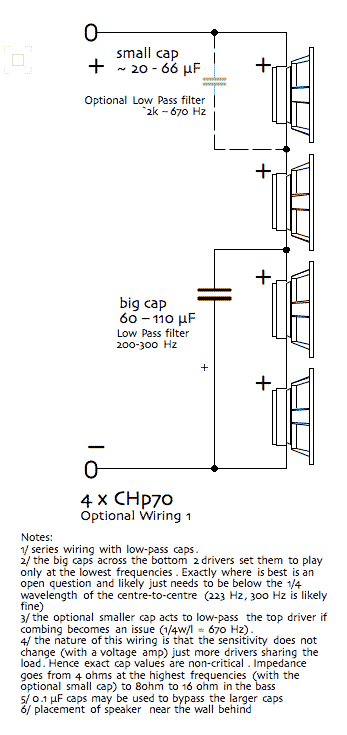
dave
We have extended the concept to 4 drivers… not sure what you'd call it. 0.75-way? (details specific to the box designed)
dave
Attachments
I'd love to know how.
Double the drivers, gain 3 dB,
Double the impedance, deliver ½ the power, lose 3dB.
Net gain, 0 dB.
That's not right. You still gain 3dB max spl in the lower frequencies (which is the limiting factor) and you don't have to lose power in the crossover to compensate for the baffle step, if designed right though.
Can 2x4 ohm series 2.5 way use either two or three drivers? Ie two drivers just doing bass duties, one doing mid and shared bass
I think we are digressing from the original question. 😱
B&W Group North America Service & Support - Home
The B&W DM 630 filter is your typical 2.5 way where the basses double up to provide 6dB bass boost or bafflestep at low frequencies. This is not the sort of speaker you want close to a wall. It sits in the middle of the room. You may not hear the bass boost, but your neighbours will. It will thump away for them. The LCR is a 1.3kHz deep notch that must work with the polycones.
A rough sim below. Not as bad as it looks, because I could rapidly tidy that up for my particular drivers. B&W use 8" polycones AFAIK, and metal tweeter. Horrible low impedance, of course.
Also below and last is the sim with just the 1mH and 8mH bass coil on the two woofers. Ridiculously bassy sound. Forget about it. 😀
B&W Group North America Service & Support - Home
The B&W DM 630 filter is your typical 2.5 way where the basses double up to provide 6dB bass boost or bafflestep at low frequencies. This is not the sort of speaker you want close to a wall. It sits in the middle of the room. You may not hear the bass boost, but your neighbours will. It will thump away for them. The LCR is a 1.3kHz deep notch that must work with the polycones.
A rough sim below. Not as bad as it looks, because I could rapidly tidy that up for my particular drivers. B&W use 8" polycones AFAIK, and metal tweeter. Horrible low impedance, of course.
Also below and last is the sim with just the 1mH and 8mH bass coil on the two woofers. Ridiculously bassy sound. Forget about it. 😀
Attachments
Last edited:
A rough sim below. Not as bad as it looks, because I could rapidly tidy that up for my particular drivers. B&W use 8" polycones AFAIK, and metal tweeter. Horrible low impedance, of course.
Also below and last is the sim with just the 1mH and 8mH bass coil on the two woofers. Ridiculously bassy sound. Forget about it. 😀
Maybe not the right solution for your problem. It is - as always - only as good as how good you are designing it. It's the same as saying "I've heard an awful BR speaker, they are all horrible". 'One fits all' rarely applies.
Hello Steve
Thank you very much for the detailed specification. My friend John will be so happy for that.
What is the reccomendation here to change? Capacitors at the tweeter fx.?
I haven't heard the speaker yet. Next Saturday we will visit John and I can tell more.
Regards,
Karoly
Thank you very much for the detailed specification. My friend John will be so happy for that.
What is the reccomendation here to change? Capacitors at the tweeter fx.?
I haven't heard the speaker yet. Next Saturday we will visit John and I can tell more.
Regards,
Karoly
You don't have any spare level to play with really. This is an efficient speaker. So I'm not sure what you can adjust.
I don't know if it helps much, but Zaph Audio did a project much like this:
Zaph|Audio. Waveguide TMM. A waveguide tweeter is quite a different animal though. But choice of crosssover, simplistic or more evolved.
Well-behaved woofer is why it works. H1215-08 CA18RNX
I don't know if it helps much, but Zaph Audio did a project much like this:
Zaph|Audio. Waveguide TMM. A waveguide tweeter is quite a different animal though. But choice of crosssover, simplistic or more evolved.
Well-behaved woofer is why it works. H1215-08 CA18RNX
I've done a couple series 2.5 ways. To be honest, don't know how they provide BSC. Perhaps something to do with the power draw? The bass tapered frequency response of the GR 165X's help. Going to revisit that crossover. Four of the Dayton DS135's sounded thin but adding the 5th seemed to work.
This gets a little weird - DIY • Canuck Audio Mart Hifi and Audio Forum
Plastic speakers - DIY • Canuck Audio Mart Hifi and Audio Forum
This gets a little weird - DIY • Canuck Audio Mart Hifi and Audio Forum
Plastic speakers - DIY • Canuck Audio Mart Hifi and Audio Forum
Hello Steve
Thank you very much for the detailed specification. My friend John will be so happy for that.
What is the reccomendation here to change? Capacitors at the tweeter fx.?
I haven't heard the speaker yet. Next Saturday we will visit John and I can tell more.
Regards,
Karoly
Hi Karoly,
It's hard to tell without being able to measure the final result and see what parts are being used already, however if you are looking for a quick mod to try, I believe B&W uses Mundorf MKP capacitors in the "upscale" version of otherwise identical speakers. Since they're my favorite value brand, it's a decent choice for you to try if these aren't already using those.
Best,
Erik
I've done a couple series 2.5 ways. To be honest, don't know how they provide BSC. Perhaps something to do with the power draw? The bass tapered frequency response of the GR 165X's help. Going to revisit that crossover. Four of the Dayton DS135's sounded thin but adding the 5th seemed to work.
This gets a little weird - DIY • Canuck Audio Mart Hifi and Audio Forum
Plastic speakers - DIY • Canuck Audio Mart Hifi and Audio Forum
The additional driver rolls off around the point of baffle step loss depending on width of baffle
- Status
- Not open for further replies.
- Home
- Loudspeakers
- Multi-Way
- 2.5 way crossover how it works?
